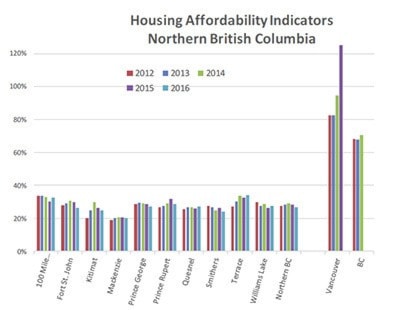Home affordability costs in 100 Mile House declined by seven per cent in 2016, according to a report put out by the BC Northern Real Estate Board.
According to the board, the Housing Affordability Indicator in 100 Mile House is at 32.3 per cent. That's the percentage of household income spent on financing home ownership. That cost includes the money spent to cover mortgage costs, municipal taxes and fees and utilities for the average single family home.
Compared to 10 other cities across Northern British Columbia, 100 Mile House had the second highest indicator. Terrace had the highest indicator in Northern B.C. with 34.0 per cent.
Increases in average house prices generally drove declines in affordability, according to the report.
Terrace, Williams Lake and Quesnel also saw their affordability dip by about 4 per cent while most communities in Northern B.C. saw improvements in their affordability.
Even with declines in 100 Mile House, when compared to affordability in the Lower Mainland and Vancouver, where the housing affordability indicator is at 125.4 per cent, BC Northern Real Estate Board president William Lacy says the area remains affordable.
"When you compare it to the Lower Mainland you are comparing apples and oranges. Even when our affordability takes a bit of a hit we are still leaps and bounds ahead of the south and we provide a great quality of life. You can get everything you've ever needed up here in the north and it's a great place to live."
That's not entirely true, according to Lisa De Paoli, who co-chairs the Poverty Reduction Coalition in 100 Mile House.
"Families come up here to be able to have a reduced cost of living and they actually find the cost of living is high," she says.
She says it's also important to consider the costs of things aside from housing. Food is more expensive in northern communities and a general lack of public transport means families rely on private vehicles and gas. Hydro costs also increase in Northern B.C. where the climate is much harsher than on the coast.
"They've already made the commitment to move up here, but once they move it's like, 'Woah, how do I have enough to pay for my food, hydro,'" she says.
The Poverty Coalition is working to reduce the struggles that families face. They meet every second Thursday, at 12:30 p.m. for an hour at the Cariboo Family Enrichment Centre. While the group tends to focus more on renters than those that own homes, they are working to increase affordability in the area by low-income families.
At their meeting on March 9, the group will be looking at encouraging local businesses to offer a living wage to workers in the area.
"People don't realize the cost of living here and we need to create a community that supports people to have some type of guaranteed income or livable income where you can afford rent and have enough food and be able to afford transportation," says De Paoli.
